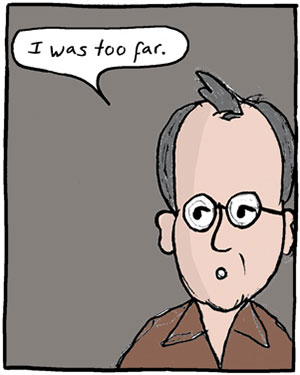Reviewed by Joshua Kors ’01E

[Graphic novel] Tom Hanks has got nothing on Ilan Stavans.
Hanks may have snagged Hollywood’s spotlight this winter for his multitude of roles in the sci-fi epic Cloud Atlas—playing a murderous thug, an ambivalent slave trader and an illiterate goat herder—but it is Stavans who is proving the season’s most versatile performer.
The Amherst professor stepped onto the national stage in 1993 as a literary critic, with Imagining Columbus: The Literary Voyage, then quickly established himself as one of the nation’s foremost lecturers, anthologists, lexicographers, translators, biographers, autobiographers and novelists. The professor hit bookshelves once again this winter, this time as a detective in El Iluminado (Perseus Books), a graphic novel by Stavans and artist Steve Sheinkin.
It is a transformation to behold.

Sporting his trademark oval glasses and a cowlick as unflagging as Tintin’s, Stavans heads to the vast desert and breathtaking brown cliffs of Santa Fe, America’s oldest capital, to give a lecture at the local history museum. Soon he is roped into the case of Rolando Pérez, a young man who recently plunged to his death under suspicious circumstances. Was it suicide or murder? Did he jump, or was he pushed because he had uncovered ancient documents revealing his family’s hidden Jewish roots?
Stavans, a Mexican-American Jew, has explored the friction between Judaism and Latin culture in dozens of books, including The Scroll and the Cross and his memoir On Borrowed Words, and his fascination with that friction flavors every line of this graphic novel. On the trail of the murderer, on the hunt for the missing documents, the professor races across New Mexico’s abandoned back roads in a Mustang convertible while recounting to his sidekick the true story of Luis de Carvajal, a 16th-century Mexican Jew. Known to later generations as “El Iluminado,” “the Enlightened One,” Carvajal created a secret temple for Crypto-Jews—outwardly Catholic families who kept their Jewish identity hidden for generations—only to have his own faith exposed by government authorities, leading to his torture and public execution. Carvajal’s story echoes throughout the novel, inspiring Rolando’s family in their time of grief, exposing clues as to the cause of his death.

El Iluminado stumbles into goofy territory now and again, playing at times like a low-budget remake of Indiana Jones, with Stavans crossing paths with a villainous Yale professor determined to capture the missing historical documents for his own nefarious purposes. Yet fast as it slips, the novel regains its footing when it sets strict plotting aside for a while and delves into more intriguing topics, such as memory, truth and the nature of reality. “The past is always fictional,” the fictional Stavans tells an incredulous police officer. “What if the world was created just a few minutes ago with us just the way we are now and with the memory of all that we’ve done until now? What if our past—yours, mine, everyone’s—is a concoction?”
A philosopher at heart, Stavans has found the right collaborator in illustrator Sheinkin, whose popular Rabbi Harvey comic strip follows the travails of a Hasidic rabbi in the Old West who foils ruthless criminals using nothing but wit and Talmudic wisdom. Sheinkin’s graphics in El Iluminado cast the Santa Fe desert in a rich, burnt orange, as if each panel passed through an Instagram filter before publication. The setting sun glows amber, crimson, then maroon behind the indefatigable Stavans, who wanders the New Mexico sands late into the night in search of clues. Sheinkin himself even steps onto the page at one point, in a hilarious cameo as a hotel clerk so clueless he can’t tell the difference between Stavans’ wife and an armed thug who’s come to murder him.
The controversy over Crypto-Jews will likely be new territory for most readers. Others will know the subject from David Gitlitz’s Secrecy and Deceit and Janet Liebman Jacobs’ Hidden Heritage. Still more will know it thanks to Family Guy, the popular animated comedy whose episode “Family Goy” followed Lois, the family matriarch, as she discovers that her lineage is actually Jewish, then faces the difficult decision of what to do about it. The characters in El Iluminado find themselves in that same unexpected situation. But the authors take it seriously, keeping the easy Jewish jokes off the page while exploring the sudden conflict that erupts within a family that has long seen itself as Catholic.
Which is not to say that Stavans’ classic, deadpan humor has gone missing. Confronted by a police officer seeking information on Rolando’s death, Professor Stavans asks whether the death has become a police matter. “No,” says the cop, “I’m researching my thesis paper.” Later, Stavans, the ever-cool detective, notices his cellphone vibrating and, though he’s being held up at gunpoint, stops to take a call from his wife, who’s seeking information as to where he put the waffle iron.
If El Iluminado becomes a bestseller, the death of Rolando Pérez may not be the last mystery for the professor to solve. In the meantime, expect Stavans to extend himself into the few remaining genres he has yet to explore: vampire adventure, legal thriller, self-help or, say, a Mexican Jewish cookbook.
Stay tuned.
Kors covers veterans’ issues for The Nation. He is a winner of the National Magazine Award and George Polk Award and is an almost fluent speaker of Spanish.